Construction of the Rusky Innovation Science and Technology Center with the goal of 2030
Attracting and promoting cooperation with advanced companies in the Asia-Pacific region centered on marine, bio, and IT technologies
'RUSSKY INNOVATION SCIENCE AND TECHNOLOGY CENTER/ RUSSKY ISTC (hereafter, Russky Center or ISTC)' is a regional technology hub for international cooperation with Asia/Pacific countries in the high-tech field. It is a special zone created by the Russian government for the development of the high-tech sector in the Primorsky Krai region, which has a weak technological base. On Russky Island, located in the south of Vladivostok, on a scale of about 250ha, it is planned to be built in stages by 2030, and on November 2020, 8, government resolution No. Tax incentives will be provided to attract leading high-tech companies in the Asia-Pacific region, and comprehensive construction of sports and leisure facilities, residential and lodging facilities, and medical facilities as well as business facilities are planned. I would like to take a detailed look at what Russia envisions for the environment and ecology center of Russia's Primorsky Krai, Russky Island, 1868 years from now.
Concepts and key areas of development
The Rusky Center takes advantage of the geographical advantage of Russky Island located in the Far East to cooperate with Asian countries such as Korea, China, Japan, Singapore, and Vietnam as its main concept and operational driving force. It plans to re-enter the Asian market with a population of about 20 billion by attracting advanced capital and technology from these foreign countries and developing new products and technologies through technical cooperation and joint ventures with Russian companies.
<Rusky Innovation Science and Technology Center’s Cooperation Plan with Neighbors>
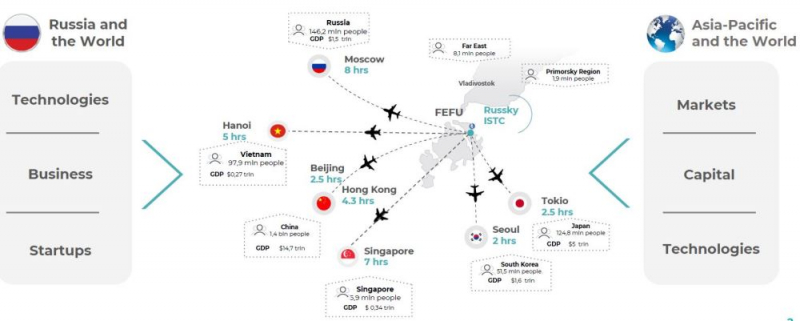
[Source: Russky ISTC]
In addition, the Rusky Center is based on the organic cooperation of three actors, public, private, and academia. In academia, the Far Eastern Federal University plays a key role. A pilot site and an actual site for the Rusky Center have been allocated inside and near the university campus, and the university's campus operation experience is utilized for the operation of the Rusky Center. In addition, the university's excellent talents with bachelor's, master's, and doctoral degrees are supplied to the Russky Center, are in charge of education programs for tenant companies, and are linked with the university's research infrastructure. The Russian government is responsible for subdivision of the center site, providing financial support for infrastructure construction, and creating a favorable economic environment for the realization of various projects and scientific innovation activities within the Russky Center. Lastly, in the private sector, companies not only directly move into the center or cooperate with resident companies to conduct research and production, but also participate in infrastructure construction and play a role in creating jobs in the technology sector.
<Private-Private-Academic Cooperation Concept Map of Russky Center>
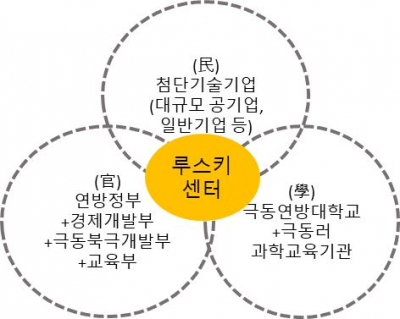
[Source: Reconstruction of the Trade Center based on Russky ISTC data]
The main development fields of the Rusky Center are △Marine, △Bio technology, △IT technology. The marine sector will focus on marine resource development, geological exploration, and ecological protection. In the biotechnology sector, not only new drugs and cell biomedicine, but also biotechnology related to industry, agriculture, and energy will be developed. Lastly, in the IT technology field, VR/AR, AI, robot, new manufacturing technology, big data, block chain, and security fields will be intensively fostered. At the Rusky Center, it is expected that companies related to the three major development fields will move in, produce products, and conduct research.
<Rusky Center's main development areas and related government documents>
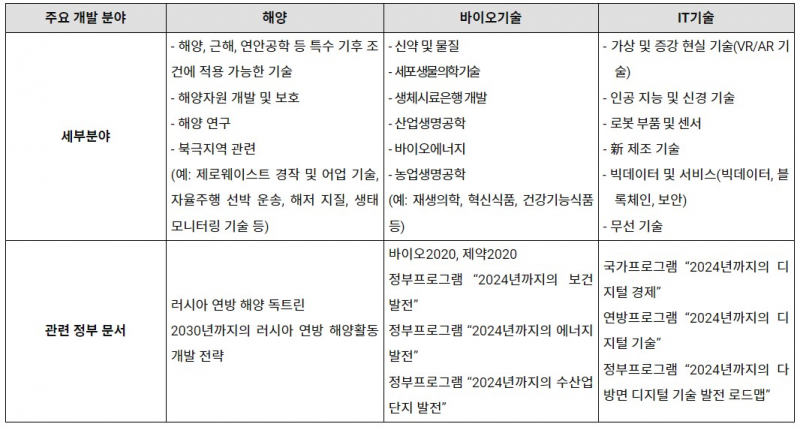
[Source: Reconstruction of the Trade Center based on Russky ISTC data]
Resident company benefits
A total of eight innovative science and technology centers are currently designated in Russia, including the Rusky Innovation Science and Technology Center in Primorsky Krai.
– Designated in 2019: Sochi 'Sirius', Moscow 'Vorobyovy Gory', 'Mendeleev Valley'
– Designated in 2020: Primorsky Krai 'Russky'
– Designated in 2021: Tula 'Composite Valley', Veliky Novgorod 'Smart Electronics-Valdai', Obninsk 'Park of Atomic and Medical Technologies', Nizhny Novgorod 'Quantum Valley'
Although the main areas of development for each regional innovation science and technology center are slightly different, they can receive basically the same tax benefits according to Federal Law No.2017 of July 7, 29 “On amendments to innovative science and technology centers and individual laws of the Russian Federation”. Compared to the Vladivostok Free Port and Advanced Development Zone, the Innovation Science and Technology Center is an economic zone specialized for science and technology-related enterprises, and provides more favorable benefits to resident enterprises in VAT, income tax, property tax, land tax, etc. compared to the above two zones.
<Comparison of benefits between Innovation Science and Technology Center and other economic zones>
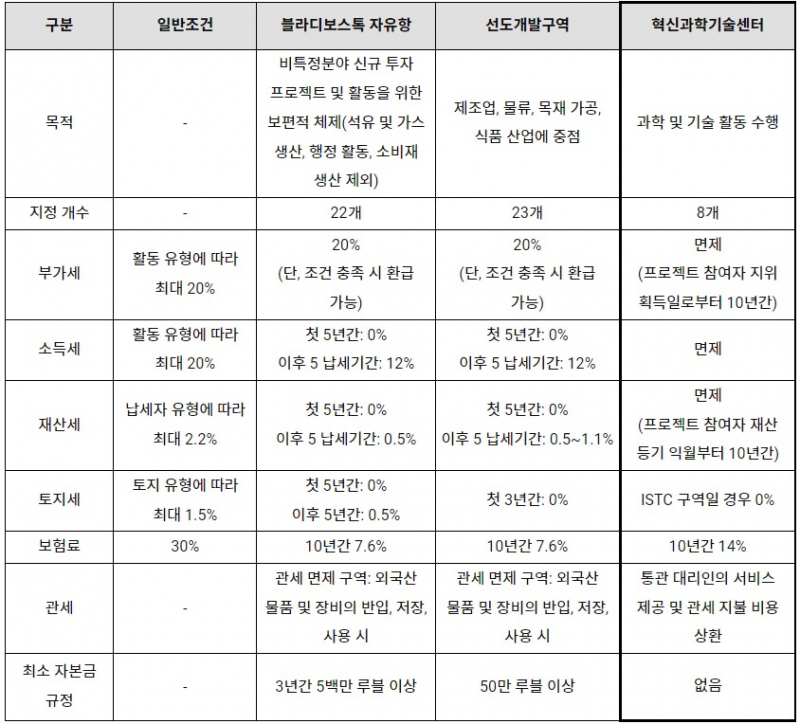
[Source: Reconstruction of the Trade Center based on Russky ISTC data]
Development plan and status
The Rusky Center will be built on an approximately 250-hectare site near the Far Eastern Federal University in Russky Island, Primorsky Krai, with a building area of 105,500m2 in the Technology and Innovation Zone, 51,640m2 in the Public Business and Sports and Leisure Zone, and 96,000m2 in Residential and Social Infrastructure. built on the scale of The site of the pilot site for first-time residents is about 0.8 hectares and the facility area is 2,500m2. The Russian government is stating geographical advantages such as walking accessibility to Far Eastern Federal University, 20 minutes by car to downtown Vladivostok, excellent ecological environment and access to the East Sea.
In the case of infrastructure, the main building including civil engineering and transportation infrastructure, R&D facilities, administrative buildings, and bicycle paths are created with the state budget, and production facilities, production research centers, residential facilities (houses, hotels, etc.), private education facilities (kindergarten, elementary school, etc.) , social and cultural facilities (supermarkets, food courts, movie theaters, shared offices, restaurants, exhibition halls, etc.) are planned to be built through private investment.
<Rusky Center site development plan (indicated in blue)>
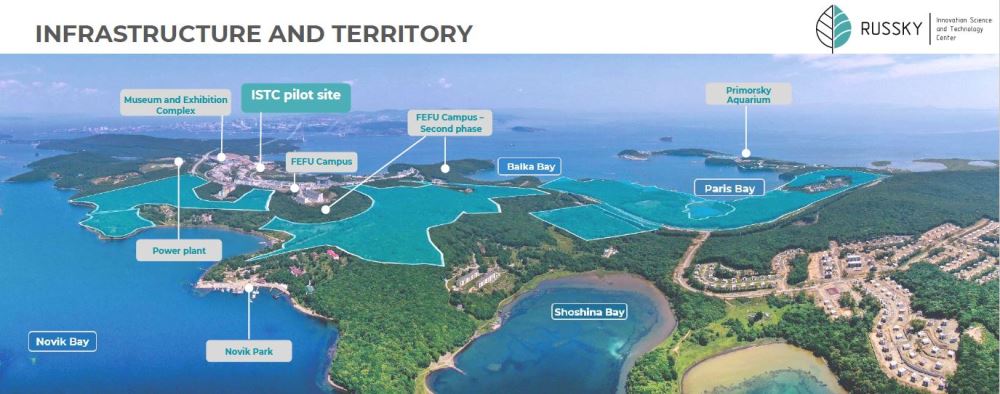
[Source: Russky ISTC]
The development of the Rusky Center is carried out in three stages. The Rusky Center expects that by 3, when the overall development is completed, there will be more than 2030 resident companies, more than 255 high-tech jobs, and more than 3,500 scientific personnel exchange visits per year.
<Rusky Center Development Area and Estimated Population by Stage>
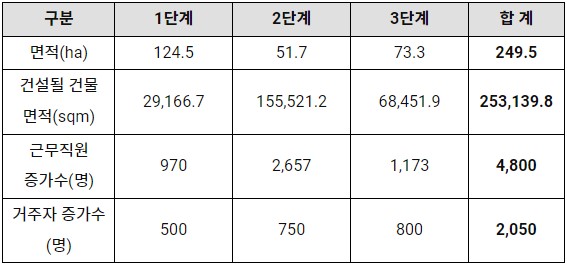
[Source: Russky ISTC]
After the resolution for the establishment of the Russky Center was enacted in November 2020, the center establishment roadmap was approved in June 2021, and at the Eastern Economic Forum held in September of that year, a total of three companies in the Russian Far East, Arnica, Antey, and Avexima, received a letter of intent (ROI). LOI) was signed. These companies are currently proceeding with the purchase of special equipment to test-produce products in line with the start of pilot site operation, which will be held on the occasion of the 6th Eastern Economic Forum held on September 9-3, 1, one year later. Arnika, a feed and food raw material manufacturing company, conducts research in the field of industrial biotechnology with Russian and foreign research institutes, and is reviewing next-generation painkillers, next-generation antiviral drugs, and functional food production, and Antey, a famous crab catching company in the Far East plans to start producing innovative products using crabs and seaweed in cooperation with the Pacific Institute of Bio-Organic Chemistry. Avexima, a pharmaceutical giant, plans to produce products with high export potential in the Asia Pacific region, such as antiviral and immunologic drugs.
Meanwhile, in September 2021, a contract was signed between the Russian Ministry of Economic Development and the Russky Center to provide federal budget subsidies worth 9 million rubles for the design of the center. proceed with After the design is completed, the first phase of construction will begin in 3, and the basic infrastructure and ISTC main building will start operating at the end of 470.
<Status and plans for each stage of the Rusky Center>

[Source: Reconstruction of the Trade Center based on Russky ISTC data]
Expert opinion and implications
Primorsky Krai is a key area for the New Eastern Policy that the Russian government has been promoting since the 2000s. In particular, Russky Island has hosted the Eastern Economic Forum every September since 2015, attracting President Putin and other major Asian countries such as Korea, China, Japan, and India. It is a symbolic place for economic cooperation between Russia and Asia-Pacific countries, visited by high-ranking officials. In the Russian Far East, where agriculture, fisheries, mining, and service industries are the main industries, establishing an innovative science and technology center on Russky Island is a way to see how Russia will cooperate with neighboring countries in the Asia Pacific and in what direction to develop the economy of the Far East. This is a good example of what can be done.
Russia's direction can be seen to be in line with Korea's Korea-Russia innovation platform project. The Korea-Russia Innovation Platform is a project that aims to create an ecosystem for technological cooperation and revitalize exchanges between Korea and Russia with the participation of the Korean Ministry of Science and Technology, MSS, MOTIE, and its affiliates. Looks like we can find a way.
However, there are still many hurdles to overcome in order to realize the blueprint that Russia expects. The CEO of the Far East Advanced Technology Fund and the director of the Russian P robot maker shared that attracting technical experts and establishing a mutually beneficial infrastructure were the main conditions for success. In order to attract overseas experts, they are of the opinion that working and living infrastructure are important for them to live and work comfortably, and that the government's interest and active investment are necessary. A, a doctor at the Far Eastern Federal University Medical Center, and A, an official at Arnika, a ski center resident company, cited financial support for high-tech projects and the provision of world-class tax benefits as important factors. High-tech projects require huge amounts of money, so government investment is required through public-private partnerships, etc., and to win competition with similar science and technology parks in neighboring countries, innovative support beyond the benefits they provide is needed.
Attention is focused on how the Rusky Innovation Science and Technology Center will highlight its unique strengths to attract foreign technology companies and compete with technology complexes in neighboring countries. In particular, in a situation in which the recent Russo-Wu crisis has put more restrictions on cooperation with foreign countries and foreign companies' business promotion in Russia, how to overcome these difficulties is expected to play an important role in the center's success in the future.
Source: Russky ISTC, ulanmedia, rg.ru, primamedia, tass, Vladivostok Trade Center



